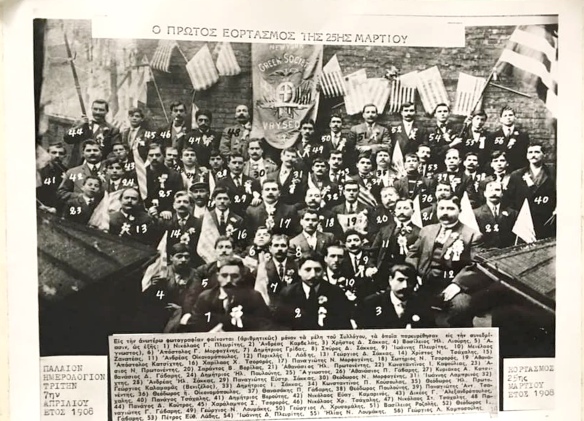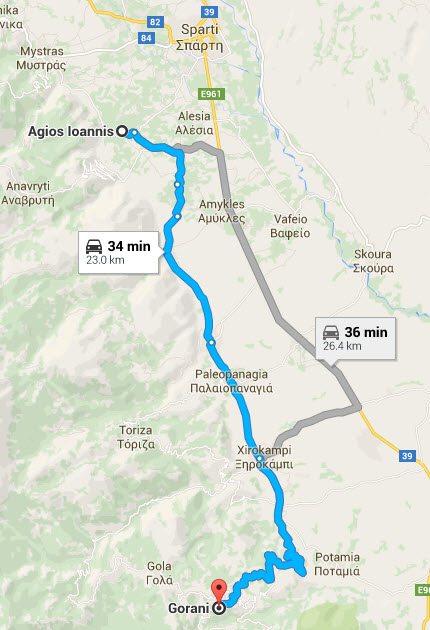When Greeks emigrated to America, they went to a city or an area where others from their village had already settled (what is known today as chain migration). With their compatriots, they formed associations to maintain traditions and build a support network. As these associations grew, they became the groundwork to collect funds to build an Orthodox Church, the foundation of their community.
The oldest and one of the largest Greek associations in New York City was formed in 1901 by immigrants from the village of Anavryti, also known as Vryseon. Located at the top of the Taygetos mountains overlooking Sparta, Anavryti was a secluded yet vibrant community of artisans such as leather makers and wood carvers. Their men were among the earliest of the Spartans to emigrate to America, and by 1908, they had formed the Vryseon Society of New York City.
The photograph below was posted to the Anavryti Facebook page on September 17, 2020 by Bertha Mendrinos. The title is “The First Celebration of the 25th of March” [commemorating the 1821 War of Independence]. In the lower left corner is written: the old calendar, Tuesday, 7 April, year 1908, indicating that the Greeks were still using the Julian calendar.
Someone had numbered the men in the photo and their names are printed in Greek. I have translated the names. Old photographs like these are priceless not only for the pictures, but also for placing the emigrants in New York City in 1908. [click on photo to enlarge]

1. Nikolaos G. Plevritis
2. Andreas Karvelas
3. Christos D. Sakkas
4. Vasileios Il. Liouris
5. Unknown
6. Apostolos G. Morfogenis
7. Dimitrios Grivas
8. Spiros D. Sakkas
9. Ioannis Plevritis
10. Menelaos Zanateas
11. Andreas Oikonomopoulos
12. Periklis I. Ladis
13. Georgios D. Sakkas
14. Christos N. Tsachalis
15. Apostolos Katsichtis
16. Harilaos Chr. Tsororos
17. Panagiotis N. Morfogenis
18. Sotirios N. Tsororos
19. Athanasios N. Protonentis
20. Sarantos V. Vorilas
21. Athanasios Il. Protonentis
22. Konstantinos I. Karoulias
23. Athanasios D. Gavaris (Tom)
24. Dimitrios Il. Pavlounis
25. Unknown
26. Athnasios P. Gavaris
27. Kyriakos A. Katsichtis
28. Andreas Il. Sakkas
29. Panagiotis Eustr. Sakkas
30. Theodoros N. Morfogenis
31. Ioannis Lambrinos
32. Georgios Kalamaras (Venizelos)
33. Dimitrios I. Sakkas
34. Konstantinos P. Kousoulas
35. Theodoros Il. Protonentis
36. Theodoros I. Oikonomopoulos
37. Thanasakis P. Gavaris
38. Theodoros Poulounis
39. Panagiotis Ant. Tsachalis
40. Panagos Tsachalis
41. Dimitrios Veroutis
42. Nikolaos. Evag. Kamarinos
43. Dikeos G. Alexandropoulos
44. Panagos D. Koutros
45. Haralampros S. Tsororos
46. Nikolaos Chr. Tsachalis
47. Nikolaos St. Tsachalis
48. Panagiotis G. Gavaris
49. Georgios N. Loumakis
50. Georgios L. Chrisomalis
51. Vasileios Rozalis
52. Theodoros I. Gavaris
53. Petros Euth. Ladis
54. Ioannis D. Plevritis
55. Ilias N. Loumakis
56. Georgios L. Kamvosoulis
These men are from the core families of Anavryti. I have seen these names in birth and baptism records in the old church books of the village. But with their new beginnings in the U.S., marriage records and the births of their children will be recorded in the Greek Orthodox churches of New York City.























